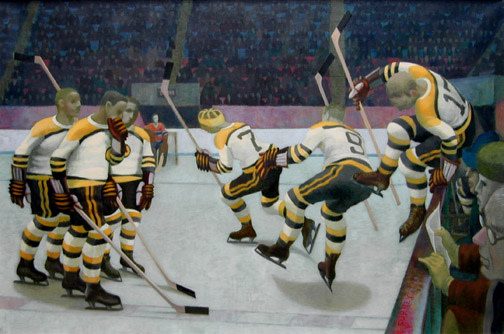Canadian Art Market in 2012
I will begin this retrospective with the comment that in my career I cannot recall a holiday season as vigorous as this. Contemporary art, the market arguably most affected by global economic concerns, surged to levels we have not recently seen. I am as delighted to report this to our readers as I am for some of our outstanding contemporary artists, who benefit from the well-placed confidence of buyers. I am also proud to announce that 2012 was a record year for sales at Klinkhoff.
Among the exceptional works we had the pleasure of placing this year was an extraordinary early salon canvas by James Wilson Morrice, painted in the impressionist style. "La Place Chateaubriand, St. Malo" c. 1899, although well-known and exhibited extensively, had been in the same collection since it was gifted by the artist's father in 1907. In her critique of the painting, Morrice scholar Lucie Dorais remarked at the extreme rarity of seeing on the market a major salon painting by the artist. We also had the great honour of selling the finest and most important Randolph Hewton. "Village on the Lower St. Lawrence", c. 1925 is a bold and spectacular work that exemplifies the spirit of the Group of Seven. In our opinion it has no equal in the artist's oeuvre.
Hewton, an especially good friend of A.Y. Jackson's, was one of three guests to display paintings in the first Group of Seven exhibition in 1920, an exhibition that altered the landscape of Canadian art. With the Painting Canada exhibition leaving a headline trail around Europe we were especially delighted to have the work back, 51 years after we last sold it. Hewton was also a founding member of the Beaver Hall Group and we are excited to reveal that planning of a major institutional retrospective featuring the artists who participated in that group's first exhibition, is now in full swing down the street at the Montreal Museum of Fine Arts. It is being orchestrated in conjunction with the National Gallery of Canada with dates likely to be set for 2014.
We have scarcely received as many inquiries about a painting as the volume we handled after releasing Robert Pilot's "Arrival of the Levis Ferry", 1924. Advances were made in post-war, too, with sales of outstanding paintings by Claude Tousignant, De Tonnancour, Brandtner, and Lemieux, to name a selection. Those following the Canadian art market this year bore witness to the resurgence of 19th century (our "old masters"), which had long suffered from a crisis of perception. We had responded numerously to this, citing the extreme paucity of important works in good condition, especially among those offered publicly.
Last spring,, on our blog, we reported the simmering cauldron of interest in that market and this fall, little deterred buyers when opportunities were present. Cornelius Krieghoff paintings were hotly contested. We placed two major Krieghoff canvases in recent months, extraordinary in preservation, quality, and importance. The first was a rare composition of Upper Canada (Ontario) painted in Canada's confederation year. The second, a classic painting of a habitant homestead, was a widely known and oft-illustrated painting that had been in the same family since 1934, the same year it had been selected for inclusion in Marius Barbeau's Krieghoff exhibition at the National Gallery of Canada. With precision-painted details only visible under close examination we are confronted with the artist's awesome brilliance as a technician. It is a showcase of Krieghoff's romanticism and ability as a genre painter. These Krieghoffs, along with the Hewton and Verner (below), will be featured in our January exhibition of Important Canadian Art.
Of all the works I will have described here, Frederick Verner's oil "Ojibwa Camp, Northern Shore of Lake Huron" is possibly the rarest. We cannot recall having seen a better one. The 1873 date, the year of the Northwest Angle treaty signing by Manitoba and the Ojibwa tribe, and to which Verner was witness, places it as an important contemporary document rather than one of the later souvenirs painted in England. The only comparable we are aware of lives in the National Gallery of Canada.
Regarding to the current auction climate, I will note that my father has written compellingly about the tremendous risks associated with auction selling. I will not repeat him at great length but will underscore that two relatively recent developments are impacting auction houses and their consignors these days. First, the sales rooms here accept too many consignments by the same artists. The temporary oversupply created each auction season dilutes buyer interest and brings prices down. Second, whereas private dealers used to buy for inventory those paintings that fell through the cracks, our colleagues are generally in agreement with us that this is no longer feasible. The exposure each painting gleans from the promotion of an auction sale and the retrievability of sales results on internet databases burns these paintings for the resale market. The focus on unrecycled paintings is an international trend we made known here on our blog some time ago.
In this latest article on the recent international Old Masters auction sales even our favourite reporter, New York Times arts editor and connoisseur Souren Melikian, seemed befuddled by the poor performance of a painting "cataloged as the work of Rubens" last sold in 2010. We observe that many buyers who want greater flexibility with their investment horizon now avoid auctions, preferring to source works without disclosing what they paid. For these reasons many outstanding paintings achieve disappointing results or remain unsold at the end of each auction season. For example, one painting by renowned artist Jean Paul Lemieux netted its consignors about $70,000 less than it would have brought them in a private sale, where it would have been more than only one of ten available. In this last season, these developments led to near-record rates of unsold paintings. We do not anticipate a change this spring and can only reiterate that, in our opinion, maximizing value without risk can only be achieved with a guarantee or private sale.
A number of markets have experienced a great year. As we have already highlighted, 19th century Canadian has seen a resurgence. This reflects the strength of the international market for Old Masters, which is fueled by connoisseurship and scarcity first, and business considerations later. In our market, great paintings offered under the right conditions generally thrived. Among the names not already mentioned, Paul Emile Borduas, Frank Johnston and John Little impressed, as did David Milne, Frederick Banting and Frederick Simpson Coburn. Works of social realism and others exploring aspects of the human condition have been growing in popularity. In addition to Lemieux, Little and Brandtner, Fred Taylor, Pegi Nicol MacLeod, Philip Surrey and Miller Brittain have been objects of great interest. William Kurelek prices held up well in spite of the quantity of supply, although there is a general consensus among our colleagues that the record setting "Wintertime North of Winnipeg" would have benefitted greatly from a private sale environment. In my opinion, the two "op art" paintings we have by Marcel Barbeau are important works of Canadian art. Barbeau has already been acclaimed for his role as a signatory of the Automatistes manifesto "Le Refus Global". His successful optical experiments of the mid 1960s, inspired to some degree by Vasarely, are original in our field and painted at the height of the international op art movement.
There is still a dearth of knowledgeable art and art market reporting in Canada. The majority of content published by mainstream media outlets is regurgitated from auction house press releases and with little critical backdrop they are slave to fashion. Our blog is written by professionals at the heart of the industry, providing news, advice and opinions (occasionally unpopular), with succulent contributions from respected art scholars and historians. This is a unique resource for observers and collectors. I would like to thank our loyal team at the Gallery, Johanne Boisjoli, John Mercier and Lynn MacNamara for their invaluable support. Thank you to our suppliers. And most of all, we remain grateful to our distinguished and highly accomplished buyers and sellers. We are proud of the relationships we have forged and the mutual benefits they have gifted. We look forward to working with you in the years ahead. Happy Holidays.
Copyright © Jonathan Klinkhoff, 2012


















